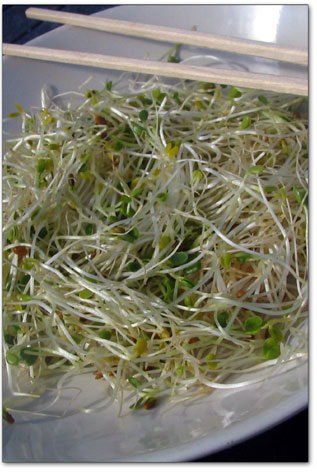| ||
Sprouts: spring’s secret weapon
by Chef Boy Ari This is a tough time of year for local-food snobs. The winter stash dwindles, and summer’s bounty isn’t here yet. My humble stash includes two chest freezers: one for meat, and one for fruits and vegetables. The meat stash contains three deer, bits of gifted elk, some hand-delivered packages of Alaskan salmon and halibut, a few local chickens, and cuts of local lamb. The meat stash is in good shape. It will hold me through to the next hunting/fishing/lambing season. But the veggie freezer is scraping bottom. Gone are the endless bags of kale, collards, spinach, peas, leeks and broccoli. The frozen peaches are gone, gone the way of frozen apricots, melons, huckleberries, raspberries, strawberries and grapes. In the root cellar the carrots are gone, the cabbage is gone, the beets are gone. I miss the dark green, leafy vegetables most. Dense with nutrients, flavor and enough fiber to shine your pipes like intestinal Brillo pads, greens are something I cannot live without. It’s ironic that now, in the season of green, the edible kinds are still so sparse. While this summer’s greens are already growing in my greenhouse, I’m not allowed to eat them yet. Lately, I’ve been hitting the produce section hard. Me eating imported greens is like a starving rabbi eating a pork chop. I do it, but with guilt, and with a grumble. And I eat it with a promise: to freeze more greens next summer. There is also my new secret weapon. It waits in the bulk bins of my local grocery store. Mung beans, alfalfa seeds, mustard seeds, garbanzo beans, wheat berries, lentils, dry-hulled sunflower seeds and dried peas – all of them living seeds that could grow into plants. These seeds contain not only the mystery of life, they also hold a solution to the dearth of springtime greens. You can sprout the seeds and in a few days they become a fresh, living food that many people consider among the most nutrient-dense on the planet. Packed with enzymes, amino acids and vitamins – many of them synthesized on the spot when the seed germinates – sprouts are a gift to your body. Some of you are getting a little nervous, wondering, perhaps, what your friends would think if they discovered you growing your own sprouts. But you would have no problem walking into a Thai restaurant and ordering the most famous dish on the menu – Pad Thai – even though shortly thereafter you will consume enough sprouts to choke a hippie. I have a cookbook, purchased in Thailand, with a Pad Thai recipe (serves four) that calls for a half-kilo of mung sprouts. That’s more than a pound! Some of the sprouts get stir-fried with the noodles and the rest get added as garnish, along with peanuts and cilantro. I don’t have enough space for the recipe here, but there are plenty out there (78,600, via Google). Sprouts can be eaten, raw or cooked, in zillions of ways. American dishes, like burgers, do well with sprouts, as do other “normal” foods like salads, soups, burritos. But sprouts somehow seem their best to me when eaten with chopsticks, as in the amazing Japanese recipe for miso-marinated black cod served on a bed of sunflower sprouts I found on epicurious.com. Here are some do-it-yourself sprouting tips from Laurel’s Kitchen (Nilgiri Press), a vegetarian cookbook from the 1970s. “Soak 1 tablespoon seeds or 1/3 cup beans in 1 quart of tepid water overnight. This is the only time sprouts should actually soak, for if they are not completely drained hereafter, they will ferment unpleasantly. “The next day, rinse the seeds thoroughly in tepid water and drain. Place in a quart jar covered with a dampened washcloth. Fasten with a rubber band and store in a dark cupboard. “Rinse the seeds or beans twice each day. Make sure excess moisture is drained off each time.” Wheat berries, which make good bread, are ready in two days; mung beans and lentils in three days. Alfalfa sprouts take five. As the little sprout tails curl around the swollen seeds, they look like sperm doing yoga. Put them in the sun for a few hours, and they’ll turn green as they synthesize chlorophyll. Then store them in the fridge. You can taste the life-power of the sprouts’ biological activity. It’s similar to the living flavor of a leafy salad, but seeds have a lot more going on than leaves. Sprouts are the vegetal equivalent of a living oyster sliding down your throat. I’ve got some mung beans before me, fresh from a steamy jar that’s been basking in the springtime sun. They sit in a little bowl on my desk, drizzled with soy sauce, garnished with a pickled pepper and a dollop of taramasalata, a Greek-style spread of whipped oil and carp eggs that I refer to as caviar mayonnaise. It tastes so rich and vital and potent, I can honestly say I wouldn’t trade it for an oyster with cocktail sauce. •
|
In this week's issue...
- May 15, 2025
- End of the trail
Despite tariff pause, Colorado bike company can’t hang on through supply chain chaos
- May 8, 2025
- Shared pain
Dismal trend highlights need to cut usage in Upper Basin, too
- April 24, 2025
- A tale of two bills
Nuclear gets all the hype, but optimizing infrastructure will have bigger impact


